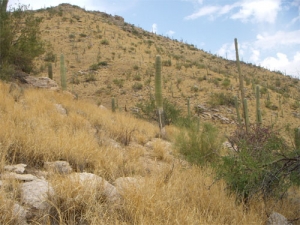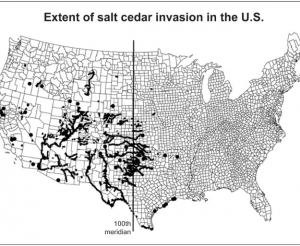Invasive Species
Many types of invasive plant and animal species have expanded and will continue to expand into new habitats in the Southwest. An invasive species is a plant, animal, or microbe that adversely affects the native ecosystem upon introduction to a new community. Invasive species are well-adapted to encroach upon new territory, and invaders compete with native species for resources like water and soil nutrients. Many invasive species are so well-adapted to diverse conditions that they can outcompete their native counterparts, leading to environmental damage and decreased biodiversity. Regional impacts of climate change, including warmer temperatures, decreased precipitation, and increased levels of carbon dioxide will affect how and where invasive species migrate and colonize.

Figure 1. A large stand of buffelgrass just west of Soldier Canyon.
| Enlarge This Figure |
Credit: Aaryn Olsson, Arizona Remote Sensing Center, The University of Arizona
Invasive species may benefit from climate change because of their ability to adapt. Temperatures and increased carbon dioxide levels in the Southwest may help some invasive species expand into new areas, requiring action from land managers, farmers, ranchers, and those involved in outdoor recreation. Some of these actions include prevention, monitoring, and eradication. Invasive species control requires understanding:
- How invasive species migrate and colonize
- Observed impacts of invasive species
- Climate change implications for invasive species
Migration and colonization
Carriers, most often humans, bring invasive species into a new area, either accidentally (through ship cargo, seed stock, livestock, or travelers) or purposefully (for food, fuel, forage, logging, biological control, recreation, or medicinal uses). Not all species introduced to an ecosystem will survive. Only 10 percent of non-native plant species are estimated to give rise to a steady population because they need the right germinating conditions, like soil type and climate.1 Colonization also depends on how many individual seeds or animals survive the transportation process. Plants with a wide geographic distribution, for example, will do better because they are more tolerant of climate and soil variations.
Certain traits enable plants to establish themselves and outcompete others for resources. These include fast-growth, a short juvenile period, bigger leaf size, and taller stem height than other plants. Invasive species tend to do well in ecosystems disturbed by natural causes, such as fires, or areas damaged by human activity, such as logging, ranching, farming, and urban expansion.
Observed invasive species impacts
The Southwest suffers from many types of invasive species outbreaks, including plants (like buffelgrass, cheatgrass, saltcedar, and red brome), animals (like bullfrogs, cowbirds, quagga mussels, and crayfish), and diseases (such as West Nile virus, rabies, and dengue fever). Invasive plants can alter the landscape by overtaking native species, facilitating fire outbreaks, and altering the food supply for herbivorous animals and insects. Buffelgrass was introduced to the region for cattle feed in the mid-1900s, but has since traveled from ranchlands into the desert ecosystem. Subsequently, these grasses have increased fuel loads in the Sonoran Desert, a region where native plants are not adapted to frequent fires. Buffelgrass-induced fires tend to be faster, longer-lasting, and hotter, and cause more plant and animal deaths than fires involving only native plants.2 After a fire, buffelgrass seeds sprout quickly, often within a few days, while many native desert plants, like saguaro cactus or palo verde trees, take months to years to re-establish themselves.

Figure 2. The known extent of salt cedar invasion in the U.S. The vertical line marks the 100th meridian, west of which rainfall drops below 45 cm yr−1 and agriculture becomes highly dependent on irrigation.
| Enlarge This Figure |
Credit: Allen Press Publishing Services
Invasive species also cause economic losses. Salt cedar, introduced in the mid-1900s to combat soil and wind erosion, has now spread to nearly all perennial drainage systems in the western arid and semi-arid U.S (see Figure 2). Research by Erika Zavaleta shows that saltcedar stands on average consume 3,000 to 4,600 m3 per hectare per year more water than regional native vegetation, leaving less available water for native plants and human consumption. In total, saltcedar in the western U.S. annually costs between $133 to 285 million in lost ecosystem services, such as irrigation water, municipal water, hydropower, and flood control.3
Management for invasive species includes using pesticides or herbicides, labor-intensive species removal, and restoration of native vegetation. Removing invasive species from agricultural or ranchlands, national and state parks, and urban landscapes requires time and money. But if uncontrolled, invaders will overtake these lands, often causing irreversible ecological damage.
Climate change implications
Currently, there is little scientific consensus on the precise impacts of climate change on invasive species, but many hypotheses exist regarding changes to dispersal and introduction patterns, colonization patterns, distribution and establishment patterns, and landscape and management practices.
As land conditions change due to climate variations, invasive species may be able to colonize new geographic areas. Climate change may allow for new travel pathways between previously separate geographic areas, increasing the potential for species interchange. Extreme weather or altered atmospheric circulation patterns could also increase dispersal to new geographical areas.4 Native species that are unable to adapt to changing conditions may die off, opening up resources for non-native plants and animals. Invasive species are more likely to have traits that help them tolerate or adapt to change, such as short juvenile periods or creative dispersal methods, and outcompete native species for soil, water, and nutrients.
As temperatures rise, landscapes currently protected against invasives by cold temperatures could become targets for invading species. Changing precipitation patterns may also allow invasive species to colonize new areas. Increased rain could allow expansion into new regions, while decreased rain could cause invasive species to die off.4
Increased levels of carbon dioxide encourage growth in some plants and decrease the necessary amount of water intake, which could put invasive plants at even more of an advantage over native plants. While both native and invasive plants will respond to increased carbon dioxide, research by Stanley Smith and colleagues suggests that some exotic species may benefit more. Red brome, an exotic grass found in the Southwest, will increase in plant size more than native grasses do under higher levels of atmospheric carbon dioxide. Red brome populations will also increase in density while native grasses populations do not.5
Invasive plants may also respond differently to management practices, like pesticide applications or removal programs, if under the influence of increased carbon dioxide. Common pesticides like glyphosate lose effectiveness on plants growing with increased carbon dioxide in the atmosphere.6 Land managers may therefore need to reassess their techniques to control invasive species.
References
- Theoharides, K. and J. Dukes. 2007. Plant invasion across space and time: factors affecting nonindigenous species success during four stages of invasion. New Phytologist 176 (2): 256-273.
- Esque, T., et al. 2007. Buffelgrass fuel loads in Saguaro National Park, Arizona, increase fire danger and threaten native species. Park Science, 24.
- Zavaleta, E. 2000. The economic value of controlling an invasive shrub. Ambio, 29(8): 462-467.
- Hellmann, J., J. Byers, B. Bierwagen, and J. Dukes. 2008. Five potential consequences of climate change for invasive species. Conservation Biology, 22(3): 534-543.
- Smith, S.D. et al. 2000. Elevated CO2 increases productivity and invasive species success in an arid ecosystem. Nature, 408:79–82.
- Backlund, P., et al. 2008. The effects of climate change on agriculture, land resources, water resources, and biodiversity in the United States. A Report by the U.S. Climate Change Science Program and the Subcommittee on Global Change Research. Washington, D.C.

